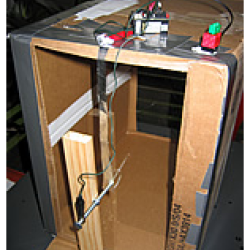Source Institutions
Source Institutions
Add to list Go to activity
Activity link broken? See if it's at the internet archive

This activity requires a Pico Cricket (tiny computer). Learners work on designing and building a sound sensor out of household materials, like plastic wrap and cardboard. This will connect with the Pico Cricket to "hear" claps and sounds. Learners then program the Pico Cricket to respond with light, motion, or music. Learn about sound waves, vibration, inputs, outputs, sensors, microcontrollers and programming.
- 10 to 30 minutes
- 2 to 4 hours
- Over $20 per group of students
- Ages 8 - 18
- Activity, Demonstration
- English
Quick Guide
Materials List (per group of students)
- large, sturdy cardboard box
- Scrap wood, two larger pieces and maybe some small scraps
- A large nut and long bolt that fit together
- Plastic Wrap
- Aluminum foil
- Double-sided tape
- Duct tape
- Mat Knife
- Hot melt glue gun and glue
- Pico Cricket kit with alligator clip sensor
- Computer
Subjects
-
Engineering and Technology
- Computing
-
Engineering
- Electrical Engineering
- Technology
-
Life Sciences
-
Human Senses and Perception
- Hearing
-
Human Senses and Perception
-
Physical Sciences
-
Vibration and Waves
- Sound
-
Vibration and Waves
-
The Nature of Technology
- The Design Process
Informal Categories
- Computers
- Electronics
- Music
Audience
To use this activity, learners need to:
- see
- read
- hear
- use keyboard
- use mouse
- touch
Learning styles supported:
- Links STEM to other topics of interest such as arts and humanities
- Involves hands-on or lab activities
Other
Components that are part of this resource:
This resource is part of:
Access Rights:
- Free access
By:
Funding Source:
- National Science Foundation, 0087813
